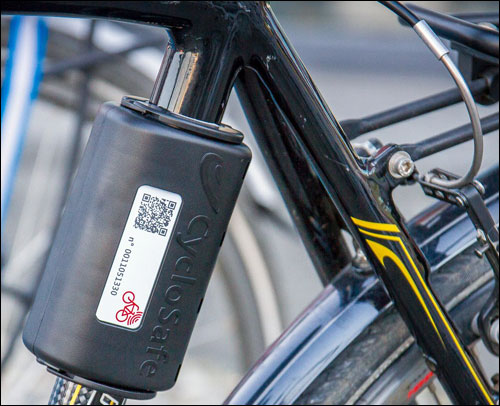Some Belgian postal workers are helping police locate missing or stolen bicycles this fall as part of their daily rounds, and they are using radio frequency identification technology to do so. As they deliver mail, some employ an RFID reader, along with a PDA with GPS capability, to read RFID tags attached to the bikes’ frames. The service, known as CycloSafe and provided by postal company bpost, has been taken live in four Belgian cities, with a small number of mail carriers in each city armed with RFID interrogators. The long-term plan is to expand the system’s use to most Belgian municipalities.
Bpost, also known as the Belgian Post Group, is a private company that delivers mail throughout Belgium. Its mailmen travel by bicycle, as well as by foot, to do their jobs. In recent years, the company has undertaken initiatives to expand the roles of its mail carriers, thereby offering non-postal services that can help communities, and to secure the jobs of their mail carriers, says Kathleen Van Beveren, the director of bpost’s Public, Health & Interim (temporary workers) business unit.

One initiative that had interested the company involved identifying missing or stolen bicycles, Van Beveren says. Bpost had been in discussions with several local municipalities and police departments regarding this issue, she adds—not only to identify where such bicycles may be located, but also to determine the owners. One cause of bike theft in Belgium is that some thieves simply “borrow” a bicycle, ride it to another location in a city and then abandon it. In this case, the bike remains in a public place, but finding it can be a difficult task for owners or the police. When police take possession of an abandoned bicycle, the department holds it for six months, but it is sold or discarded if not claimed after that time.
“We thought we should do something for bike security using our mailman network,” Van Beveren says. While some stolen bikes taken back to a thief’s home, where they cannot easily be located, she notes, many are simply discarded at another location. This often happens around schools, universities and train stations. Bpost began seeking a solution, and discovered that though there were RFID-based tracking systems available to identify bicycles, the tags were difficult to read. For example, bpost found an RFID-tagging system used on bikes in the United Kingdom, but the tag is built into a bicycle’s metal frame, and the seat must be removed in order to read that tag. In addition, the read range is very short. Bpost envisioned a solution with a read range of 1 or 2 meters , so that a postal carrier could simply walk past one or more bicycles and read all of their tags without slowing down.
Identification and mobility technology firm Zetes designed the RFID solution for bpost’s CycloSafe service, according to Hervé Toussaint, Zetes Belgium’s manager.
Bicyclists can sign up for the service at the CycloSafe website, or at a local bpost office or bicycle shop, by purchasing a CycloSafe device consisting of two Confidex RFID on-metal tags embedded in a plastic housing that locks onto a bike’s frame. Both tags are encoded with the same unique identification number, which is also printed on the device’s exterior. Having two RFID tags—one positioned on a bike’s left side, the other on its right—ensures that a reader can quickly capture the ID from either side of the bicycle.
The device costs €30 ($38), which includes three years of service. If the bike is lost or stolen, the user can go online and report that information, and the software will then update the bike’s status as missing.
A postal carrier is issued a 1128 Bluetooth ultrahigh-frequency (UHF) RFID reader made by Technology Solutions (UK) Ltd. (TSL). When the carrier comes upon a bike equipped with a CycloSafe device, he or she can remove the reader from its holster (worn at the waist), and press its button to capture the bike’s tag ID number. The interrogator forwards that data to a PDA via a Bluetooth connection, and the PDA pushes the ID, along with its GPS-based location information, to the bpost server. There, Zetes software identifies whether that tag has been listed as belonging to a stolen or missing bicycle. If, in fact, the bike has been listed as missing, the software can forward that data to the local police department. The police also have access to the server and can decide whether to investigate or forward the data to the bike’s listed owner.
An enterprising thief could break the CycloSafe device off a bicycle, Van Beveren says, but doing so might make it difficult for that person to sell the bike, since it would not have the CycloSafe to verify ownership. However, she says, the majority of bikes are simply “borrowed” and discarded, and in such situations, it is unlikely a thief would bother to remove the device. If the legitimate owner ever sells the bike, he or she can provide the CycloSafe registration certificate to the new owner, who can then go online and update the CycloSafe database accordingly.
Zetes selected the Confidex tag for the CycloSafe device because it could provide approximately 1.5 meters (5 feet) of read range, even when attached to a metal bike frame. The reader is powered by a rechargeable battery, which can typically last the length of a mail carrier’s eight-hour shift—especially, Toussaint points out, since the reader will not be used constantly, but only when a mailman determines there are bikes in the vicinity that he or she would like to identify. The reader can either vibrate, emit a sound or illuminate an LED light each time it captures a tag ID. However, she adds, the carrier is not required to personally determine whether a bike is stolen, or to take any action if it is.
Bpost aims to benefit from using the system through increased revenue from sale of the devices and service, as well as improve its own public image. What’s more, the new service promises to increase job security for mail carriers, by adding one more role to their duties. For now, only a small number of carriers in the four initial cities (Brussels, Bruges, Ghent and Leuven) are being equipped with readers, Van Beveren says. She declines to reveal the exact number, but says it is more than a few. Bicycle stores have begun stocking the devices, and she predicts that adoption will increase as consumers become aware of the technology. “We just started selling,” she states, “and haven’t done much marketing.”


